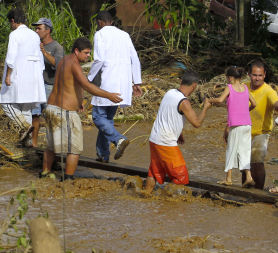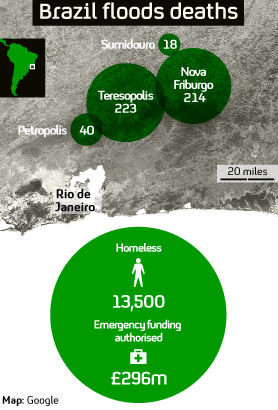Brazil floods: more than 500 killed
 Alex Thomson
Chief Correspondent
Alex Thomson
Chief Correspondent
As the number of people killed in the Brazil floods passes the 500 mark, one scientist tells Channel 4 News that replacing coastal vegetation with urban development has contributed to the disaster.

Rescue workers in Brazil are preparing for more rain as they attempt to reach areas cut off by massive floods and landslides.
In one of the country’s worst natural disasters, rivers of mud tore through towns in the mountainous Serrana region outside Rio de Janeiro, leveling houses and stranding thousands of residents.
In a rare moment of hope a 6-month-old baby was rescued from the rubble of a house, drawing thunderous cheers from residents.
“It looks like the war in Vietnam.” Albertino Lazaro
But mostly there is despair.
“What happened here is absurd. It looks like the war in Vietnam,” said Albertino Lazaro, 54, who took shelter in a gymnasium set up to house displaced families in the town of Teresopolis, where at least 223 people were killed.
“It’s a lot better than being out there in the mud,” he said of the shelter as children played soccer among families sleeping on mattresses.
More than 500 people are now known to have died, but rescuers have yet to reach some of the worst-hit parts of Teresopolis, including one neighborhood where around 150 houses were believed to have been destroyed.
More than 13,500 people have been left homeless.
The flooding is expected to have caused billions of dollars in damage and has presented President Dilma Rousseff with her first crisis only two weeks after she took office.
Poor infrastructure
Flooding – particularly flash flooding with effects such as mudflows and landslides – is common in south east Brazil.
Dr Harvey Rodda is an associate of the Benfield UCL Hazard Research Centre.
“The natural coastal forest vegetation which can protect the deep tropical soils has largely been cleared.” Dr Harvey Rodda
He told Channel 4 News that the land around Rio de Janeiro is prone to serious flooding: “The steep terrain means water in streams, rivers and surface runoff is faster flowing with more energy and more erosive power.
“Also the natural coastal forest vegetation which can protect the deep tropical soils has largely been cleared, it is estimated only 12 per cent now remains.
“This has been replaced with agriculture or urban development.
“The biggest problem is the uncontrolled urban development where dwellings are poorly constructed, often shanty towns, sited in high risk areas without any drainage infrastructure. When heavy rainfall occurs which is a feature of the climate, flash flooding ensues with much loss of life.”

‘Race against time’
Up to half of the people killed in severe flooding in Brazil are feared to be children.
Many more deaths are expected as heavy downpours continue to drench parts of the country.
Heloisa Oliveira is Save the Children’s Country Director in Brazil: “The rain is showing no signs of easing and thousands of children’s lives are at risk. The water is racing through villages at high speed, dragging everything with it and leaving children and their families with nothing to hold on to.
“People are scrambling to find places to live in, finding shelter in any public building they come across which has not been flooded or damaged.
“Many are in desperate need of water, food, shoes and clothes. It is now a race against time to get through to these families and help them survive this disaster.”
Food prices
Beyond the loss of life and property, the damage from the rains could further boost food prices in parts of southeastern Brazil, a major concern for the government.
The Serrana region is an important producer of fruit and vegetables for the Rio area but the floods have not affected Brazil’s main crops such as soy, sugar cane, oranges and coffee.
Rio, famed for its beaches and Carnival, will co-host soccer’s World Cup in 2014 and host the Olympics in 2016.